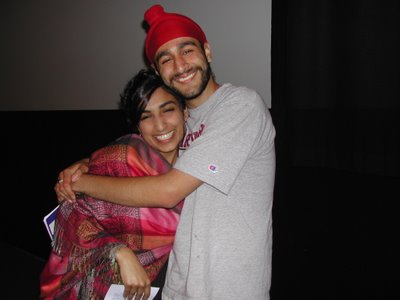Crossing East (and West)
In less than 24 hours, I will be on a plane to India. When I began the journey to make Divided We Fall, I promised myself that I would travel to India once it was done and give myself time to explore and think and write. Nearly five years later, the film is almost complete, and I am about to cross east for my first real break in years.
For a moment, I stop my frenzied packing, sit down between books, medicines, and clothes thrown across my bed, and stare at the pink and black hearts on the wallpaper of my childhood bedroom. When I was a little girl, I used to spend hours in this room, writing in my journal, wondering if anyone would ever hear the stories I had to tell. Now I am twenty-five, and if I think back to the past month alone, I have to catch my breath: people are listening – on radio, on television, and on the big screen.
In May and June, the stories of my film Divided We Fall and Sharat Raju‘s first film American Made began to enter the public sphere:
And we just held the final advanced screenings of Divided We Fall at Harvard and Stanford universities.
These events are like fireworks to me – promises that our personal stories can be seen and heard by the mainstream public, crossing east and west. Here are glimpses…
ON THE RADIO
 In 1913, Kehar Singh crossed an ocean to arrive on the Pacific shores of California. Nearly one hundred years later, the first public radio series on Asian American history Crossing East tells the story of this early Sikh American pioneer – my grandfather (pictured). The segment takes audio clips directly from Divided We Fall. You can read the transcript and listen online (Segment B). The program is still playing live around the country. You can find your local station and tune in.
In 1913, Kehar Singh crossed an ocean to arrive on the Pacific shores of California. Nearly one hundred years later, the first public radio series on Asian American history Crossing East tells the story of this early Sikh American pioneer – my grandfather (pictured). The segment takes audio clips directly from Divided We Fall. You can read the transcript and listen online (Segment B). The program is still playing live around the country. You can find your local station and tune in.
I remember my father calling me after he heard the program air for the first time. There was excitement in his voice: “I had always wanted Dad’s stories to be told. I had never imagined this was possible.” For the first time, we felt that our history – the history of Sikh Americans and more broadly Asian Americans – were recognized and remembered as part of the making of America, our home.
ON TELEVISION
I have seen American Made, the first film by my director Sharat Raju, too many times to count, but nothing could prepare me for the thrill of watching on my own television set. When Edie Falco of the Sopranos introduced the film on PBS’ Independent Lens, I held my breath: this was the first time a fictional story about Sikhs in post-9/11 America was shown on television. In its first week of airings, American Made had more than half a million viewers.
While we can count the number of people who watch, it is impossible to measure the impact of sharing stories never told before. It may be impossible even to see the impact at first. But I have learned from history that the first sign of cultural change is the moment when personal stories of suffering emerge in mainstream national consciousness. Since September 11, 2001, the daily lives of many Americans – Sikhs, Muslims, Arabs, South Asians, even Latinos, anyone who seems to resemble the ‘bad guys’ – have been changed in ways large and small, yet their stories have barely captured national attention. To me, American Made on television is a small step in this direction. I hope that Divided We Fall can be part of the next step…
ON THE BIG SCREEN
We have screened the director’s cut of Divided We Fall at both Harvard and Stanford Universities in the last few weeks – our last advanced screenings before we make our official US premiere this September. Both screenings were special events for me.
At Harvard on May 7, we screened Divided We Fall before a packed theater of friends, family, colleagues, crew members, and complete strangers. That morning, the Boston Globe had run an article about our screening in the Entertainment Section (right next to ads for movies like MI III), so the Carpenter Center’s theater was full. The Pluralism Project sponsored the event (thanks to Diana Eck’s invitation and Kathryn Lohre’s hard work) and the Harvard Film Archive hosted us. My academic advisor and director of the Pluralism Project Diana Eck welcomed the audience and introduced Sharat and me. She was gracious and kind, and I thanked her for supporting me in this project for nearly three years now. I then took a deep breathe and introduced the film. Then we sat down.
The strange thing about making a movie is that you would think showing it would be the easiest part. After all, all the hard work is over. No performance is necessary: you just have to make sure the projectionist makes the movie play. But screening a new film is hard. The mind races: Will the audience laugh at the funny parts? When will you hear the weight of silence? Will they applaud at the end and will it sound more than polite? When our film was done, the audience not only applauded but slowly began to stand up. I began to realize what was happening: they were giving us a standing ovation. It was a surreal moment and I cherished it.
Diana facilitated our discussion with the audience at the end. We fielded all kinds of questions – why did you include the Japanese American internment? what was the most difficult and inspiring parts of making this film? what are the next steps? – and then the very last man who stood up (known as “Brother Blue”) made a request to us: “Please travel with your film as much as possible. Hearing your stories makes such a differenc
e… I commend you.” It was a beautiful ending. The Pluralism Project posted pictures of the event.
Afterward, we went out for dinner with our friends: Tracy Wells (director of communications), Deonnie Moodie (story consultant), Jessica Jenkins (director of research who flew out from Washington, DC), Brynn Saito (long-time supporter who came from New York City) and even Matt Blute (our cinematographer who flew out from California)! It was a grand night. (My friend Currun Singh and me pictured below…)

Stanford University was our next stop. It seemed only appropriate that our last advanced screening was at the university where I began the journey to make this film. On June 3, the director’s cut of our film was the morning feature of the first Bay Area Spinning Wheel Film Festival. When introducing the movie from the stage of Cubberly Auditorium, I looked out to see my thesis advisors in the audience – Linda Hess, Joseph Brown, and Rob Reich. They were also in the audience when I presented my senior honors thesis in June 2003 in a lecture room just next door. Exactly three years later, the student project they mentored has become a feature-length film: a direct result of their care and instruction. I felt lucky to be able to acknowledge them.
Laura Selznick, founding director of Stanford’s Undergraduate Research Programs, was also in the audience. She was responsible for the grant that put me on the road in the months after 9/11. Sean Fernandes, one of our interviewees in the film, and Sharon Gibson, our story consultant, was also there. My parents Dolly and Judge and my brother Sanjeev were there too. It was a full house: family, friends, and teachers from my college life. The screening was a success and in fact, the entire day turned into one long joyful reunion for me. I am grateful to Mandeep and Parveen Dhillon and to the whole Spinning Wheel family for supporting our film once again.
IN THE STUDIO
The picture is locked (translate: the editing is done, the story is sealed, now we put it in the hands of professionals to perfect the sound and color). The last thing I had to do was record my voice-over narration in a professional sound studio in Burbank, CA, the DubStage, where movies are made. I had headphones for the music, a big screen for the picture, and a mic for my voice. I was on my feet for eight hours, doing take after take, reciting the words that have now become imprinted in my brain, until we finally completed the film. When I finished, one of the last frames of the movie was still up on the screen: a widow holding her grandchildren. I love this scene. I have seen this movie hundreds of times and although my mind is numb to most of it, there are still some parts that break me – like the ending. Some stories are too powerful to ever become stale.
WHAT’S NEXT
Now I leave in the film in the hands of my trusty team and steal a summer adventure in India. No school, no film, no goals of any kind. I am just going to wander, journal in hand. I cannot remember the last time I did this (maybe when I was eight). I would not be able to take this break without Sharat and our team (especially Jess, Tracy, and Sharon), who will spend the summer preparing for our premiere in the fall. We haven’t made any official announcements about this yet… but check in with us in August!
Until then, I thank everyone reading this online journal for sharing in this mad film journey for the past year! We are ending one chapter and will soon open a new one: from making the movie to bringing it into the world in the upcoming year…

